Abscesos Hepáticos Piógenos Múltiples: ¿Una Patología Superada O Un Reto Médico Vigente?: Un Caso A Recordar
Autores/as
DOI:
https://doi.org/10.37980/im.journal.rmdp.20211789Palabras clave:
absceso hepático, absceso piógeno múltiple, patología hepáticaResumen
El absceso hepático piógeno es una patología que aún en nuestros días supone un reto médico, ya que su curso clínico suele ser grave, el diagnóstico frecuentemente tardío y la mortalidad elevada. En las últimas décadas hemos asistido a diversos avances, como la introducción de los antibióticos de amplio espectro y el desarrollo de técnicas de imagen e intervencionistas que han mejorado la eficacia diagnóstica y el pronóstico de esta patología. Pese a ello, la presencia de abscesos hepáticos piógenos múltiples no es una patología superada y presentamos un caso clínico que ilustre esta patología y justifique que ha de tenerse en cuenta en el arsenal diagnóstico para poder tratarlo precozmente y disminuir así su alta morbimortalidad.
Publicado
Número
Sección
Licencia
Derechos de autor 2021 Infomedic Intl.Derechos autoriales y de reproducibilidad. La Revista Médica de Panama es un ente académico, sin fines de lucro, que forma parte de la Academia Panameña de Medicina y Cirugía. Sus publicaciones son de tipo acceso gratuito de su contenido para uso individual y académico, sin restricción. Los derechos autoriales de cada artículo son retenidos por sus autores. Al Publicar en la Revista, el autor otorga Licencia permanente, exclusiva, e irrevocable a la Sociedad para la edición del manuscrito, y otorga a la empresa editorial, Infomedic International Licencia de uso de distribución, indexación y comercial exclusiva, permanente e irrevocable de su contenido y para la generación de productos y servicios derivados del mismo. En caso que el autor obtenga la licencia CC BY, el artículo y sus derivados son de libre acceso y distribución.






